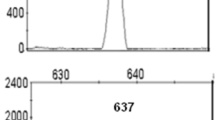Abstract
Objective of the study is to assess the prevalence of Connexin 26 (GJB2) mutation in patients with congenital nonsyndromic sensorineural hearing loss in Bulgarian population. Study design is done prospectively. Patient inclusion criteria for this study were diagnosis of congenital nonsyndromic hearing loss, and absence of potential sibling relationships between patients included in the study (anamnestic pedigree for at least three generations). Patients were excluded from the study group if one of the following conditions were present: secondary hearing loss (cytomegalovirus, rubella, meningo-encephalitis, mastoiditis, other infections, posterior fossa tumors, etc.), exposure to drugs or other prenatal or perinatal etiology of deafness, and congenital syndromic hearing loss. Genomic DNA samples from whole blood were tested with sequence analysis for mutations in the coding region of the GJB2. Results state that 51 patients were analyzed for GJB2 mutations. Twenty of the patients (39%) with mutant alleles were homozygous for the c.35delG mutation (c.35delG/c.35delG) and four patients (8%) presented as heterozygotes (c.35delG/WT). In one patient, who carried a heterozygous mutation c.35delG, a second mutation was found—312del114. Additionally, in two other patients were discovered the mutations Trp24X (W24X) and, respectively, Arg127His(R127H), both in heterozygous states. From the whole study group there was only one patient with compound heterozygous genotype—p.Leu90Pro(L90P)/p.Ile121Asn. The latter one has never been reported in the literature so far. In conclusion, this study determines the importance of connexin 26 mutations in Bulgarian children with severe to profound congenital nonsyndromic sensorineural hearing loss, the prevalence of the different mutation variants and their relationship with the ethnical background of the patients. In addition, we report for the first time a novel mutation in the GJB2 gene.
Similar content being viewed by others
References
Gorlin RJ, Toriello HB, Cohen MM (1995) Hereditary hearing loss and its syndromes. Oxford, UK
Xu L, Hu Y, Nance W et al (2001) Epidemiological studies on hearing impairment with reference to genetic factors in Sichuan China. Ann Otol Rhinol Laryngol 110:356–363
Hochman JB, Stockley TL, Shipp D et al (2010) Prevalence of Connexin 26 (GJB2) and Pendred (SLC26A4) mutations in a population of adult cochlear implant candidates. Otol Neurotol 31:919–922
Lazăr C, Popp R, Trifa A et al (2010) Prevalence of the c.35delG and p.W24X mutations in the GJB2 gene in patients with nonsyndromic hearing loss from North-West Romania. Int J Pediatr Otorhinolaryngol 74:351–355
Bruzzone R, White TW, Paul DL (1996) Connections with connexins: the molecular basis of direct intercellular signaling. Eur J Biochem 238:1–27
Kumar NM, Gilula NB (1996) The gap junction communication channel. Cell 9:381–388
Kikuchi T, Adams JC, Miyabe Y et al (2000) Potassium ion recycling pathway via gap junction systems in the mammalian cochlea and its interruption in hereditary nonsyndromic deafness. Med Electron Microsc 33:51–56
Propst EJ, Stockley TL, Gordon KA et al (2006) Ethnicity and mutations in GJB2 (connexin 26) and GJB6 (connexin 30) in a multi-cultural canadian paediatric cochlear implant program. Int J Pediatr Otorhinolaryngol 70:435–444
Gasparini P, Rabionet R, Barbujani G et al (2000) High carrier frequency of the 35delG deafness mutation in European populations. Eur J Hum Genet 8:19–23
Green G, Scott D, McDonald J et al (1999) Carrier rates in the Midwestern United States for GJB2 mutations causing inherited deafness. JAMA 281:2211–2216
Morell RJ, Kim HJ, Hood LJ et al (1998) Mutations in the connexin 26 gene among Ashkenazi Jews with non syndromic recessive deafness. N Engl J Med 339:1500–1505
Park C, Levilliers J, Hardelin JP (2001) Molecular genetics of hearing loss. Annu Rev Genet 35:589–645
Van Laer L, Coucke P, Mueller RF et al (2001) A common founder for the 35delG GJB2 gene mutation in connexin 26 hearing impairment. J Med Genet 38:515–518
Green GE, Mueller RF, Cohn ES et al (2003) Audiological manifestations and features of connexin 26 deafness. Audiol Med 1:5–11
Gopalarao D, Kimberling W, Jesteadt W et al (2008) Is hearing loss due to mutations in the connexin26 gene progressive? Int J Audiol 47:11–20
Denoyelle F, Marlin S, Weil D et al (1999) Clinical features of the prevalent form of childhood deafness, DFNB1, due to a connexin-26 gene defect: implications for genetic counselling. Lancet 353:1298–1303
Minarik et al (2003) Most frequent GJB2 mutations among Slovak Caucasian and Slovak Gypsy patients with non-syndromic hearing loss (NSHL). Presented at the European human genetics conference, Birmingham, England, 3–6 May 2003
Thönnissen E, Rabionet R, Arbonès ML et al (2002) Human connexin26 (GJB2) deafness mutations affect the function of gap junction channels at different levels of protein expression. Hum Genet 111:190–197
Acknowledgments
This study was funded by a grant from the Medical University of Sofia in 2009.
Conflict of interest
Authors report no conflict of interest in the publication of the article.
Author information
Authors and Affiliations
Corresponding author
Rights and permissions
About this article
Cite this article
Popova, D.P., Kaneva, R., Varbanova, S. et al. Prevalence of GBJ2 mutations in patients with severe to profound congenital nonsyndromic sensorineural hearing loss in Bulgarian population. Eur Arch Otorhinolaryngol 269, 1589–1592 (2012). https://doi.org/10.1007/s00405-011-1817-2
Received:
Accepted:
Published:
Issue Date:
DOI: https://doi.org/10.1007/s00405-011-1817-2




